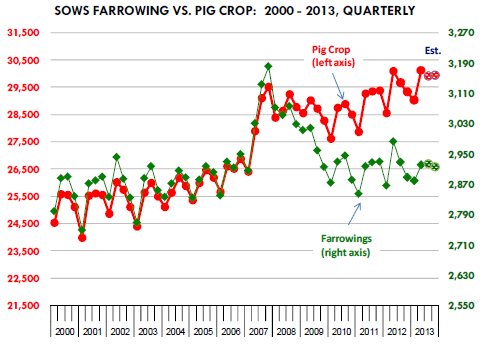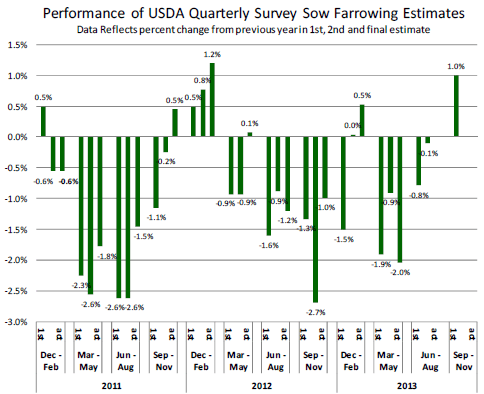



CME: Hogs & Pigs Report Supportive of Short-term Hog Prices
US - The latest USDA "Hogs and Pigs" report could be construed as supportive of hog prices in the short term but with implications for higher supplies, and possibly lower prices, in 2014, write Steve Meyer and Len Steiner.USDA reported that as of 1 June, there were 66.647 million hogs and pigs on US farms, slightly less than a year ago. Prior to the reports, analysts were looking for a 0.6 per cent increase in the total inventory.
The smaller than expected inventory fits well with current conditions on the ground and the strong hog prices in June. Hog supplies have not been as large as earlier expected, in part due to a larger than expected decline in the number of pigs farrowed during the previous quarter but also because of a steady decline in the number of hogs coming to the US from Canada.
The breeding inventory, which tends to have more of an impact on the outlook for 2014, actually was larger than previously expected. The USDA survey pegged the breeding stock at 5.882 million head, about 48,000 head more than the previous quarter and some 20,000 head or 0.3 per cent higher than a year ago. Prior to the report analysts were actually expecting a modest decline in the breeding inventory.
It is quite telling that US hog producers have been able to slightly increase the number of breeding animals despite some of the highest feed costs on record and implied negative margins for much of the past 12 months. As we noted in our report discussing analyst estimates (6/27), producers have become more adept at managing risk and deploying strategies that minimized the impact of rising feed costs last fall and winter.

The inventory of market hogs was 60.765 million head, 0.1 per cent lower than a year ago compared to pre-report estimates that were expecting a 0.75 per cent increase. The inventory of feeder pigs under 50 pounds was 19.676 million head, 1 per cent lower than a year ago. The decline in market hogs comes even as the pig crop for Mar - May was actually slightly higher than the previous year. Fewer pigs coming from Canada and possibly death losses due to the outbreak of PEDs virus may have reduced the number of pigs available for marketing in the short term.
The smaller supplies imply lower slaughter in Q3 and part of Q4. The report showed that producers expect farrowings for June - August to be about the same as a year ago while farrowings for September - November were one per cent higher than the previous year. This implies larger pig crops when accounting for the steady growth in the number of pigs saved per litter. Indeed, during Mar - May, pigs saved per litter set a new all time record high at 10.31, 2.2 per cent increase from the previous year.
We still think the rate of pigs saved per litter will slow down to 1-1.5 per cent growth rate but that expectation was firmly disproved in the latest survey. We currently estimate the pig crop for Jun - Aug to be up 0.9 per cent based on current farrowing estimates and continuing increases in pigs per litter. These are pigs that will come to market during Nov - Jan.
The pig crop for Sep - Nov (which corresponds to slaughter for the period Feb - Apr) is expected to be up 2.2 per cent. Bottom line: The report indicates that hog supplies in the short term will be smaller than earlier expected but expectations for lower feed costs down the road could induce producers to slowly expand.

Further ReadingYou can view the full CME report by clicking here. |
Further ReadingYou can view the Hogs and Pigs report by clicking here. |








